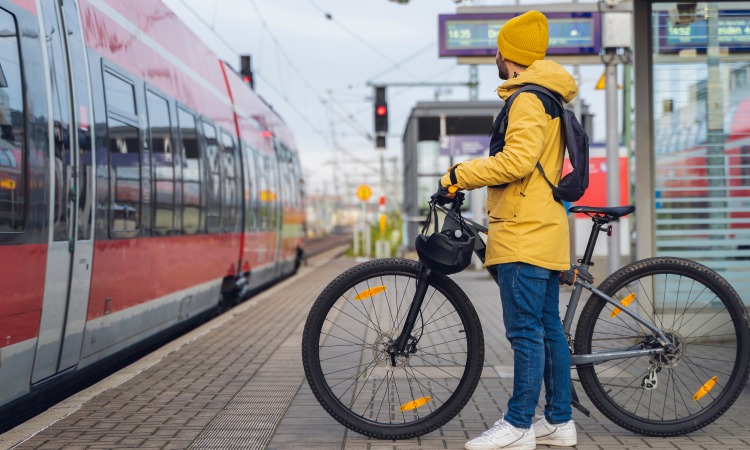MaaS: Bringing systematic change to mobility
- Like
- Digg
- Del
- Tumblr
- VKontakte
- Buffer
- Love This
- Odnoklassniki
- Meneame
- Blogger
- Amazon
- Yahoo Mail
- Gmail
- AOL
- Newsvine
- HackerNews
- Evernote
- MySpace
- Mail.ru
- Viadeo
- Line
- Comments
- Yummly
- SMS
- Viber
- Telegram
- Subscribe
- Skype
- Facebook Messenger
- Kakao
- LiveJournal
- Yammer
- Edgar
- Fintel
- Mix
- Instapaper
- Copy Link
Posted: 25 July 2022 | Sampo Hietanen - MaaS Global | No comments yet
Founder and CEO of MaaS Global Ltd, Sampo Hietanen, discusses what Mobility-as-a-Service could mean for the future of mobility, and examines what is needed to build the basis of a successful and sustainable mobility ecosystem.


One of MaaS’ most important missions is to build an ecosystem and emphasise collaboration between actors on the field to form a bigger entity that, together, can start a change in the system”
Mobility-as-a-Service (MaaS) is different in how it approaches everything regarding mobility – from sustainability to accessibility and data-sharing. In order for the industry to deliver it effectively and efficiently, it has to have a strong basis, and that requires a lot of groundwork. Right now, one of MaaS’ most important missions is to build an ecosystem and emphasise collaboration between actors on the field to form a bigger entity that, together, can start a change in the system. And this group of transport service providers, MaaS operators and cities must listen to each other, and the users must be ready to change and constantly improve in order to grow the market.
A strong ecosystem makes strong MaaS
Planning and implementing a new concept that transforms an industry takes time, and MaaS is only just starting out. Changing the mindset around car ownership means making a systematic change in the whole mobility industry, and that requires teamwork. We, as an ecosystem, must find a solution that is as appealing and easy to use as a private car, but – most importantly – we must approach this from the consumer perspective. We cannot do this alone, because there is nothing that can be as significant for such a large group of users, or as sensible a solution to mobility problems, as a car. It has to be a combination of things.
Changing the mindset around car ownership means making a systematic change in the whole mobility industry, and that requires teamwork”
After all, it is first and foremost the consumers’ view on mobility that we must change to make MaaS work. Right now, all mobility services – from Uber to public transport – constitute only 24 per cent of consumers’ mobility budget, while private cars take up the remaining 76 per cent. What is not taken into account, however, is that the car is in use for about four per cent of the time and the rest it spends in a parking lot or garage. It is the availability and flexibility of it that drives people to acquire a car, and the perceived lack of those features in other modes of transport that pushes them away. So, it is this mindset that we must change.
But we cannot solve every problem at once. MaaS providers are constantly working on problem-solving and finding solutions to ones that might arise in the future, and this is necessary in order for anyone to develop to their full potential. The car has been a staple of human mobility for about 100 years, and any kind of change that could truly encourage people to switch to MaaS solutions cannot happen overnight. We need to constantly develop ourselves and listen to our ecosystem and our users about where we can improve, now and in the future. Equally, problems exist in the current system, and we are likely more blind to them because we are so used to them, but these are the kind of blind spots where MaaS can enter and help to develop better mobility.


From sustainable thinking to open APIs
As we try to create systematic change throughout the whole mobility industry, this change must take sustainability into account”
As we try to create systematic change throughout the whole mobility industry, this change must take sustainability into account. By default, MaaS is a more sustainable option to private cars, but it must not be taken for granted. We cannot approach the environmental crisis that we are facing solely by thinking that we can reduce carbon emissions by switching to a bus or buying an electric car. Getting relevant and reliable data on consumers’ travel habits and how they impact the environment depends on the connectability of our systems and teamwork.
For the last five years, we have mainly focused on developing our technological capabilities and the different modes of transport that MaaS includes. Transport service providers have started to plan and implement their own technological solutions in order to focus on growing their business and to be able to open up to the ecosystem. It is becoming clear that transport providers are keen to ensure that they have technology that allows them to join the MaaS ecosystem.
We are also seeing, more and more, different pricing models where we get closer to the price perception of the car. The amount of supply is increasing, and this includes providers who cross national borders and operate in several countries, perhaps even globally. In the coming years, we will see an increase in combining mobility with living. One of these is MaaS Global’s pilots CondoMaaS and TownMaaS, in partnership with Mitsui Fudosan in Japan.
Towards a new normal
Since 2019 and the start of COVID-19 pandemic, opinions about joining the MaaS ecosystem have clearly started to change faster. There has been a great amount of necessary ecosystem conversation and growth in the background. It is strange to even think that the COVID-19 pandemic has done something good, but perhaps it has taught us to appreciate things that were already there. It has also certainly changed how we perceive time and transport in general, since now there is no nine o’clock train that we have to catch every morning, but we can plan our travel around the rest of our schedule, instead of it making our plans for us. All the time, the amount of different transport providers joining the MaaS ecosystem continues to grow and attract more and more users.
Instead of thinking about what everyone else gets and how everyone connects to me, we should think how we, as a community, profit from this and how we can connect to others”
But it has to be remembered that it is not enough to receive data of where your train or e-scooter is, or when it might be there. It is all very well to find the mode of transport, but you have to be able to unlock it or pay for your ticket on the same app. So, it is not enough that we discuss data and opening our APIs, but instead we should make sure that we are fully integrable. Every transport service provider who wants to join the MaaS ecosystem should have programmable interfaces in order for others to be able to connect with them. This concept of opening up our APIs and sharing our data with everyone can be intimidating, and is one of the reasons that MaaS is not sometimes seen in a very favourable light. But, instead of thinking about what everyone else gets and how everyone connects to me, we should think how we, as a community, profit from this and how we can connect to others.
Because, in the future, those who are able to connect to others are the winners.
Sampo Hietanen is the inventor and pioneer of the Mobility-as-a-Service (MaaS) concept. He is the Founder and CEO of Finland-based MaaS Global Ltd, the world’s first MaaS company and the company behind the award-winning Whim app.
Hietanen’s vision for the sustainable future of mobility is partly technological, but fundamentally human: “The technology is already here. All we need to do is figure out our customers’ dream and build the services to match it.”
Related topics
Accessibility, COVID-19, Journey Planning, Mobility Services, Multimodality, Passenger Experience, Public Transport, Sustainable Urban Transport, Ticketing & Payments
Issue
Issue 2 2022
Related organisations
MaaS Global
Related people
Sampo Hietanen








